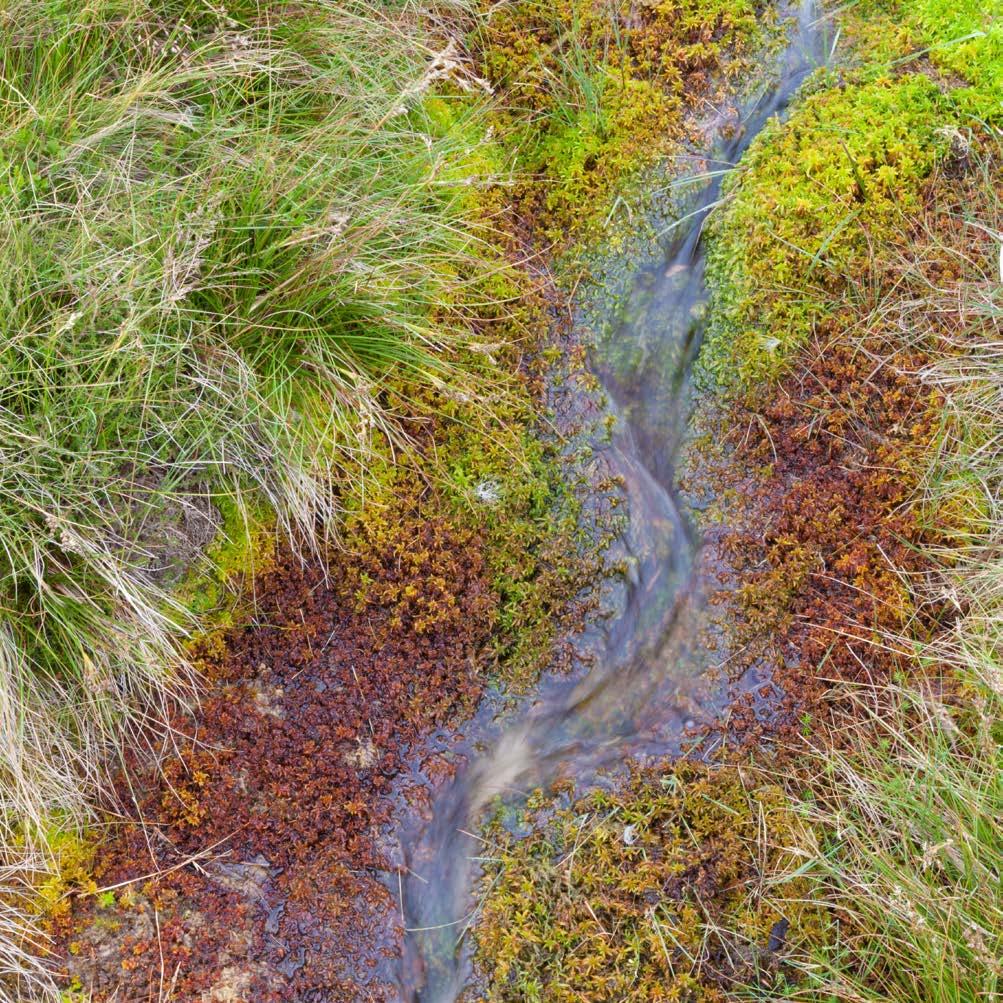
4 minute read
Making Space for Water
Kinder Scout, Derbyshire, England, United Kingdom
The primary objective of the Making Space for Water project was to demonstrate how restoration can aid in reducing flood risk while also creating wider benefits. This project was executed in two phases (2009-2015) by the Moors for the Future Partnership; the project provided evidence about the impact of bare and eroding peat stabilization on upland blanket bog habitat in the South Pennine Moors Special Area of Conservation (SAC). An ecological restoration toolkit used to restore blanket bogs for Natural Flood Management (NFM) benefits was tested within one-hectare experimental headwater catchments, and attempts were made to identify the mechanisms through which NFM benefits are realized.
Article cover: Sphagnum moss holds up to 20 times its weight in water. (Photos by Moors for the Future Partnership)
Producing Efficiencies
In the upland catchment for the River Trent, moorland restoration, gully and grip blocking, and changes in land management are all actions that have been identified. Hydraulic modelling, as part of the Lower Derwent Flood Risk Management Strategy, demonstrated that upstream land management could offset the impact of climate change to benefit Derby, providing benefits during smaller, more frequent flood events.
The project has been effective in providing empirical evidence about the NFM benefits of severely degraded (bare peat) blanket bog habitat stabilization. Bare peat restoration by revegetation and gully blocking offered benefits for downstream flood risk reduction by “slowing the flow” in peatland headwater catchments; modelling demonstrated the benefits at larger catchment scale.
Using Natural Processes
The facultative nurse grass crop was designed to temporarily stabilize the bare peat surface and ameliorate environmental conditions so the target “blanket bog” plant species could become established. The grass species only survive as long as top-up treatments of fertilizer are applied. Only one grass species used in the nurse crop mix persists: wavy hair grass, which is a blanket bog species.
Dwarf shrub heath plants were planted into the nurse crop and these readily became established.
Sphagnum was also introduced. Replicated trials of the different forms of Sphagnum available to date have been conducted. Ongoing monitoring shows that Sphagnum has become established and cover is increasing on the site.
Locally sourced stone and timber gully dams were constructed in order to slow water velocities and trap sediments. These dams filled with sediment and peat, and these channels will become vegetated over time.

Broadening Benefits
Within the project, 84 hectares of severely damaged blanket bog habitat within the SAC, the South Pennine Moors Special Protection Area, the Dark Peak Site of Special Scientific Interest, and the Peak District National Park (European Union designations) have been stabilized.
Vegetation recovery was also monitored, with available results showing that by 2014, after four growing seasons, bare peat cover had declined by 88 percent, replaced mainly by a dominant cover of grasses (mainly wavy hair grass) and acrocarpous mosses. Restoration by revegetation and gully blocking has led to a reduction of depth to the water tables and peak storm discharge; an increase of overland flow production and storm-flow lag times; and attenuating storm hydrograph shape.

Promoting Collaboration
The Environment Agency of England’s Making Space for Water project was funded by the Department for Environment, Food, and Rural Affairs and delivered by the Moors for the Future Partnership. This Partnership includes the National Trust, Peak District National Park, the Royal Society for the Protection of Birds, Natural England, Severn Trent Water, the Yorkshire Water Environment Agency, United Utilities, and Pennine Prospects. The blanket bog stabilization/ restoration methods tested for NFM benefit in this project are commonly and widely delivered across the country. It is a standard method within Higher Level Stewardship plans and approved by Natural England and landowners.











